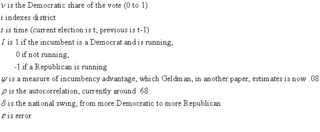I am all for running everywhere, and the 50 state strategy.
But neither we nor the Republicans are running everywhere (at least not yet!) In this series, I will look at where we are not running (I am not going to look at where Republicans are not running, as I have no desire to help Republicans, however modestly)
This diary is partly inspired by the great work done by BENAWU.
crossposted to dailyKos
In previous diaries, I looked at TX, OH, IL, MD, MS, WV, KY, PA, NC, NM and IN; today, NC where the deadline is 2/29 and NE, where it is 3/3
The numbers after each are a) Cook PVI and b) A rating of the district based on a model I created details here – basically a logistic model based on a lot of demographics; the number is the predicted probability of being Republican, based solely on the demographics (details here . I also have a model that includes Cook PVI, but, well….I give you the Cook number too.
NC has 13 congressional districts, 6 are held by Republicans, 7 by Democrats
NE has 3 districts, all Republican
The districts held by Democrats are
Confirmed
district Cook Prob Repub Incumbent Challenger? rating
NC-01 D+9 .28 Butterfield No
NC-02 R+3 .50 Etheridge No
NC-04 D+6 .44 Price No
NC-07 R+3 .40 McIntyre Yes Safe
NC-11 R+7 .73 Shuler Yes Vul (?)
NC-12 D+11 .15 Watt No
NC-13 D+2 .39 Miller No
basically, all these seats are pretty safe except maybe Shuler’s.
As for the Republicans
NC-03 R+15 .61
NC-03 is a bizarrely shaped district on the eastern part of NC, bordering on the Atlantic. It’s gerrymandered with NC-01. NC-01 is 50% Black and has median income of $28,410 (one of the lowest in the USA). NC-03 is 17% Black and has a median income of $37,510; OK, only some of that is land that could be either CD…but….
Jones, first elected in 1994, has not been seriously challenged since, although his opponents recently have had no money. He has recently become much less conservative, having a full about-face on the war. That accounts for a primary challenger.
His Democratic challenger is Marshall Adame , a kossack
NC-05 R+15 .79
NC-05 is the northern central part of NC, along the VA border.
Foxx, first elected in 2004, was the survivor of a nasty Republican primary that year. She won her general election relatively easily, though still getting 30,000 votes fewer than Bush did.
This year, one Democrat has announced Roy Carter , and several others might run: You can read about a debate they had in this live blog diary .
NC-06 R+17 .76
NC-06 is a weird shaped district in the middle of the state. One reason it’s so odd is to let NC-12 run along and through it, stopping at every Black community; another is so that NC-02 can carve the Black areas out of the eastern part of NC-06. So, NC-02 is 30% Black, NC-12 is 45% Black, NC-06 is 9% Black.
Coble, first elected in 1984, has not been seriously challenged in decades. But he’s getting old, and doesn’t appear to have filed. The latest news on his campaign website is from 2004.
The only announced challenger is Johnny Carter.
If Coble runs, he will be tough to beat. If he retires…well,it’s still a Republican district, but things could get interesting.
NC-08 R+3 .37
NC-08 is the southwestern part of NC, along the SC border.
Hayes, first elected in 1998, has faced tough fights, never getting 60% and only once getting 55%. In 2006, he beat Larry Kissel by 329 votes out of 121,000, in one of the closest races in the country.
Kissell is running again, and several others may run. Kissell announced his run right after the last election. This time the DCCC is fully behind Kissell. And Larry is a frequent poster on daily Kos
NC-09 R+12 .64
NC-09 is another odd shaped district, this one in the southern central part of NC, bordering SC. Again, this one is weird because of NC-12.
Myrick, first elected in 1994, has won easily since, against underfinanced opponents. In 2004, she got 17,000 more votes than Bush.
There are two formally announced challengers:
Ross Overby . Ross seems like a moderate. One nice feature on his website, though, is a button “if you usually vote Republican, click here”. In a district like NC-09, a winning Democrat has to appeal to Republicans
and
Harry Taylor who seems more progressive.
and one who seems to be running: Bill Glass, who ran in 2006.
NC-10 R+15 .70
NC-10 is a north-south strip, separating the western tip of the state from the rest.
McHenry, first elected in 2004, won fairly easily against under-funded opponents. He got about the same number of votes as Bush in 2004
His Democratic opponent this time is Steve Ivester
NE-01 R+12 .66
NE-01 is the eastern third of NE, excluding Omaha
Fortenberry, first elected in 2004, has had surprisingly tough races. In 2004, he won 54-43, and in 2006, he won 58-42, both times against well-funded opponents, in races that cost roughly $2 million each, about evenly split between incumbent and challenger. In 2004, he got 26,000 votes less than Bush.
There are no confirmed challengers. Maxine Moul, the 2006 challenger, may run again.
NE-02 R+9 .41
NE-02 is Omaha and suburbs
Terry, first elected in 1998, had his toughest race in 2006, when he won 55-45, despite outspending Jim Esch by about 2-1.
There is no confirmed challenger. State Sen Tom White may run
NE-03 R+24 .76
NE-03 is the vast, western 2/3 of NE; more rural than 92% of all districts.
Smith, first elected in 2006, had a tough race against Scott Kleeb, winning 55-45 (Bush, by contrast, got 75% in 2004)
Kleeb may run again

